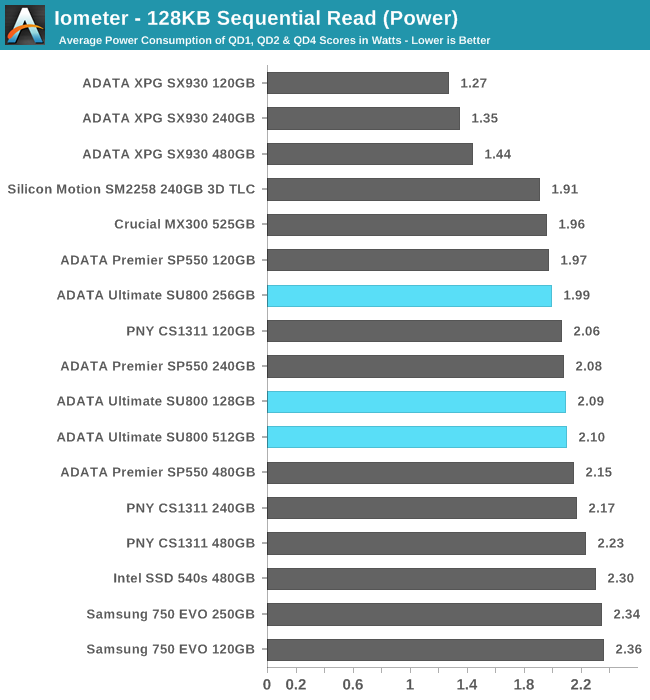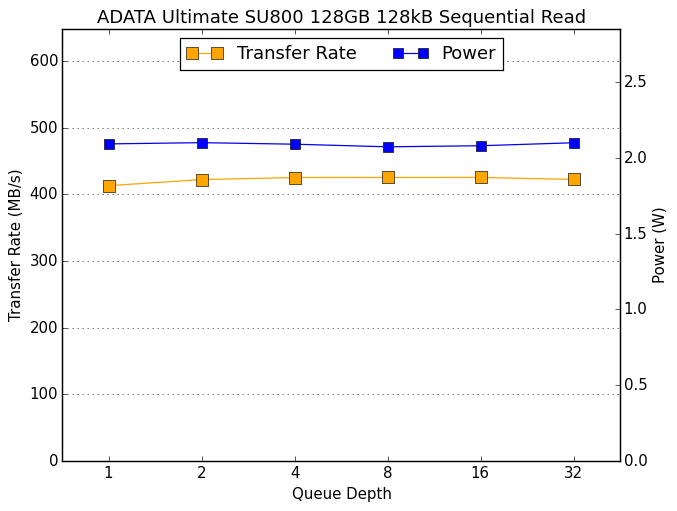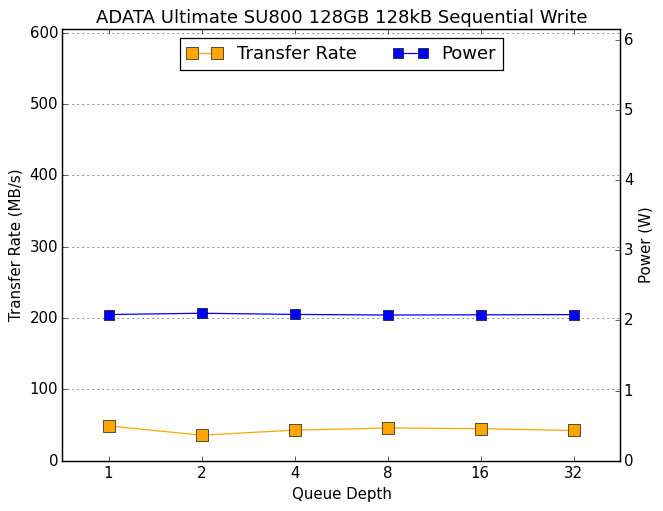The ADATA Ultimate SU800 SSD Review (128GB, 256GB, 512GB)
by Billy Tallis on February 1, 2017 12:01 PM ESTSequential Read Performance
The sequential read test requests 128kB blocks and tests queue depths ranging from 1 to 32. The queue depth is doubled every three minutes, for a total test duration of 18 minutes. The test spans the entire drive, and the drive is filled before the test begins. The primary score we report is an average of performances at queue depths 1, 2 and 4, as client usage typically consists mostly of low queue depth operations.

The smallest capacity of the ADATA SU800 has the slowest sequential read speed of all the drives in this comparison, as it only has flash connected to three of the controller's four channels. The larger SU800s saturate the SATA connection.

The SU800's power consumption is middle of the road for TLC drives, giving the larger two capacities slightly better than average efficiency. The ADATA XPG SX930 demonstrates that MLC NAND flash still has a significant efficiency advantage.
 |
|||||||||
The larger two capacities of the SU800 show modest performance improvement across the first half of the test, while the 128GB model exhibits almost no scaling.
Sequential Write Performance
The sequential write test writes 128kB blocks and tests queue depths ranging from 1 to 32. The queue depth is doubled every three minutes, for a total test duration of 18 minutes. The test spans the entire drive, and the drive is filled before the test begins. The primary score we report is an average of performances at queue depths 1, 2 and 4, as client usage typically consists mostly of low queue depth operations.

The sustained sequential write speeds of the SU800 are quite poor, but this is no surprise after seeing how much a full drive hurt performance on the ATSB Heavy and Light tests.

Power consumption is at least better than average, so the SU800 isn't too far behind the average for efficiency.
 |
|||||||||
Aside from the initial effects of filling up the SLC cache, performance and power consumption during sequential writes don't scale with queue depth on the SU800.










35 Comments
View All Comments
RamIt - Wednesday, February 1, 2017 - link
Why is there no comparison to the Intel 600p recently reviewed?extide - Thursday, February 2, 2017 - link
Probably because it is a PCIe drive. A shopper who is shopping for SATA drives is probably not interested in a PCIe drive.dj_aris - Thursday, February 2, 2017 - link
Sorry, but since all SATA 3 drives top at theoretical 600MBs but SSD speeds are WAY faster than that, what is the point in testing them?Death666Angel - Thursday, February 2, 2017 - link
It might just be my eyes, but I see a lot of instances where the drives don't actually achieve the 600MB/s data cap of the SATA3 protocol....dj_aris - Thursday, February 2, 2017 - link
Indeed, but who cares if it's 600 or 500 or even 300, when you can reach 2000+ using modern pcie storage (with similiar prices). SATA is dead, obviously will not be developed anymore, SATA express drives don't even exist. I mean we don't test DVD drives or floppies, right?doggface - Thursday, February 2, 2017 - link
Sata is dead? Seriously?Also, similar prices?
So many things wrong with this post.
Sata SSDs will continue to thrive for years to come. No doubt about that, and while they do, we will need reviews on their performance to help differentiate the good from bad. Especially as the industry continues to peddle TLC and even possibly QLC drives.
vladx - Thursday, February 2, 2017 - link
Upcoming QLC NAND is not something to scowl at. SSD drives using this technology will not be targeted to compete with MLC or even TLC instead they are planned for archival purposes: https://www.pcper.com/news/Storage/FMS-2015-Toshib...Billy Tallis - Thursday, February 2, 2017 - link
SATA isn't dead, but it is a dead end in the same sense that VGA ports are.extide - Thursday, February 2, 2017 - link
Not everyone's system is compatible with and/or cannot boot from NVME drives. There is definitely still a need to have these data points.lopri - Thursday, February 2, 2017 - link
Two of my boards refuse to accept any M.2 drive as a boot drive, leaving me no choice but to go with SATA. Plus SATA is nowhere near dead because it is still much more affordable. Plus there is no convincing argument as to why backups have to be saved in SSDs.